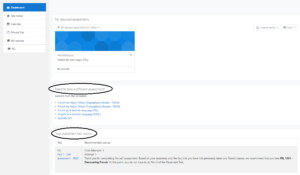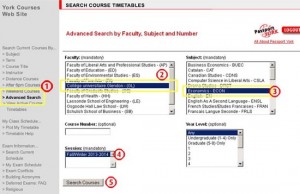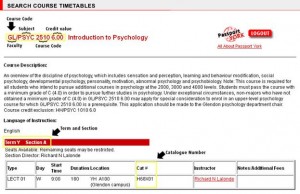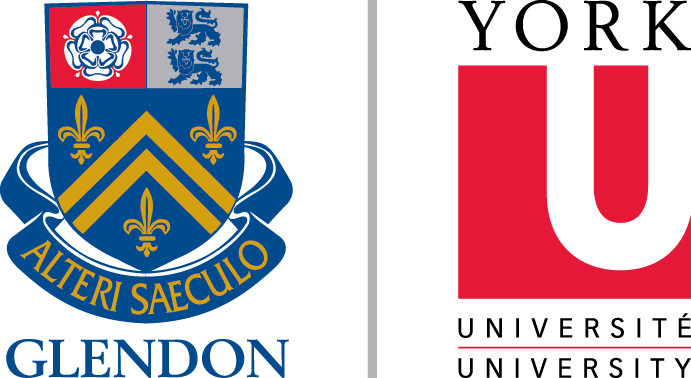WINTER COURSE SELECTION
OVERVIEW OF YOUR ENROLMENT PROCESS
1. CREATE YOUR PASSPORT YORK ACCOUNT
- Go to http://accounts.yorku.ca.
- Click on New Student Sign Up!
- Follow the prompts to create your Passport York username and password.
2. COMPLETE YOUR LANGUAGE PLACEMENT TEST
3. GET TO KNOW YOUR DEGREE REQUIREMENTS
Degree Requirements Module
Be sure to watch our online Degree Requirements Modules to familiarize yourself with the components of a Glendon BA/BSc.
Academic Calendar
The Academic Calendar is the official source of your degree requirements. Make sure to consult your requirements here throughout your studies.
Some programs are offered by more than one Faculty (e.g., Faculty of Health offers a Psychology program). Please make sure to consult the program requirements for the Faculty of Glendon.
Academic Calendar
The Academic Calendar is the University’s official reference document for all academic programs, policies and requirements.
Certificate Program
A prescribed set of courses that define a specialization in a particular area of studies. Usually comprised of 24 to 36 credits, certificate programs can be taken as either part of or independent from a degree program. For more information, visit the Future Students website.
Degree Program
A prescribed set of courses and accompanying requirements that lead to a degree (e.g. Honours Bachelor of Arts – Honours BA) upon completion.
Double Major
An equal concentration of courses taken in two subject areas – only available in an Honours (120 credit) degree. Note: graduating with a double major does not mean you will receive two degrees upon completion. You will receive one Honours degree with two identified specializations that will appear on your transcript.
Faculty
A large academic division of the University that offers programs in related disciplines. For example, the Faculty of Science & Engineering offers programs in Biology, Chemistry and Physics. The School of the Arts, Media, Performance & Design offers programs in Music, Dance and Film.
Grade Point Average (GPA)
Every letter grade received at York has a numerical value (e.g. B+ = 7) attached to it. In this way, an average of all your grades can be calculated. GPAs are assessed at the end of an academic session or cumulatively, taking all courses ever completed into consideration. For more information, visit the Grade Report Legends page.
Honours/Bachelor
A Bachelor’s degree requires the completion of a minimum of 90 credits or equivalent. An Honours degree requires the completion of a minimum of 120 credits or equivalent.
Major
A primary concentration of courses taken in one subject area within a degree program. Normally, a major requires at least 30 of the 90 credits required for a Bachelor’s degree or 42 of the 120 credits required for an Honours degree.
Minor
A secondary concentration of courses taken in one subject area within an Honours degree. Normally, a minor requires at least 30 of the 120 credits required. Minors are not available in a Bachelor’s degree or in a Specialized Honours degree.
Passport York
The verification system that acts as your electronic signature for online tools.
Prerequisite
A prerequisite course must be satisfied before you can enrol in your requested course or program. For example, Glendon’s Biology program has high school science prerequisites. York courses can also have other York courses as prerequisites. For example, you must successfully complete GL/PSYC 2510 6.00 with a minimum grade of C before you can enrol in any other PSYC courses.
Session
An academic session (e.g. Fall/Winter 2021-2022) is a prescribed period of time designed for the delivery of courses.
Sessional Dates
Each academic session has a first and last day of classes among a host of other benchmark dates. For more information, visit the Important Dates page.
Stream
An academic focus within your major (e.g. Cognitive Neuropsychology Stream). Not all majors have a stream.
Transfer Credit
If you attended another post-secondary institution before coming to York, you will be assessed for and may be granted transfer credit towards your York degree. This transfer credit may count towards the total number of credits required and it may exempt you from specific York degree requirements. For details, check your transfer credit statement issued at the point of admission. If you change your program, your transfer credit may need to be re-assessed. An academic advisor can help you understand your transfer credit.
Undergraduate/Graduate
The first degree pursued after admission from high school or equivalent is your undergraduate (Bachelor’s) degree. Once you have graduated from your Bachelor’s degree, you may pursue graduate-level studies towards a Master’s or Doctorate degree.
4. SELECT YOUR COURSES & PLAN YOUR SCHEDULE
Winter Course Offerings
Begin by consulting the personalized Winter Course Offerings document sent to you by an academic advisor. You can enrol in a maximum of 15 credits this Winter term.
Contents of the Winter Course Offerings document
- Major courses available
- French language courses
- General Education courses
- Upper-level courses*
*NOTE: Students who were granted transfer credits might be advised to take third and fourth year courses based on their remaining degree requirements.
Double Major or Minor
You should let an academic advisor know if you’re interested in pursuing a double major or a minor. They’ll make sure to recommend relevant courses.
1. Pay attention to the information you received in your Winter course offerings list
- Prioritize your required courses.
- Choose 1000 and 2000-level courses only unless otherwise advised by an academic advisor.
- Choose a maximum of 30 credits (5 courses in Fall and 5 courses in Winter).
- Follow any guidelines on which term (Y, F, or W) or section (A, B, etc.) to choose for a course (if specified).
2. Use the Visual Schedule Builder (VSB)
- Visual Schedule Builder (VSB) is an online self-serve tool that helps plan your course schedule. It lets you graphically view schedule options and create a timetable based on the courses and times that work best for you. VSB arranges selected courses into conflict-free timetable options and displays them in an easy-to-read weekly schedule.
- The Visual Schedule Builder does not register you in courses. It helps you create an optimal course schedule plan. You will then have to enrol in courses through the Registration and Enrolment Module (REM).
3. Build a schedule you can handle
- Remember to schedule in time for commuting, sleep, family, relaxation, studying, work, exercise, and extracurriculars.
- Full-time status
- Minimum of 9 credits per semester (18 total in Fall + Winter).
- If you’re registered with a permanent disability, minimum of 6 credits per semester (12 total in Fall + Winter).
NOTE: Full-time status may be required for OSAP and RESP purposes as well as other government aid.
- Part-time status
- Less than 9 credits per semester.
- If you’re registered with a permanent disability, less than 6 credits per semester.
- Make sure that your Fall and Winter schedules are balanced.
- Only take a maximum of 6 hours of class a day (i.e. two courses in a day).
4. Check your class location
Unless you’re prepared to take a 45-minute shuttle bus ride to class and back, do not enrol in courses with the Faculty code other than “GL”. Generally speaking, you should be checking the location of your class; if it says “Glendon Campus”, it will take place at Glendon. Click here for a list of York University Building Acronyms.
Using the York Courses Website (Lecture Schedule)
Go to the York Courses Website. Bookmark this page now!
Using the Advanced Search function
- Click on Advanced Search from the menu options on the left.
- Faculty – Select Collège universitaire Glendon (GL)
- Subject – Select the Subject of the course you are searching for
- Session – Choose Fall/Winter 2021-2022
- Click Search Courses
Use these steps to search for ALL courses, including General Education courses: Humanities – HUMA, Modes of Reasoning – MODR, Natural Science – NATS, and Social Science – SOSC
Example: How to find the course “GL/MODR 1711 6.00 Critical Thinking”
- Faculty – Collège universitaire Glendon (GL)
- Subject – MODR
- Session– Fall/Winter 2021-2022
- Click Search Courses
Find GL/MODR 1711 6.00 on the following page and open the “Course Description and Schedule” link.
When you click on the Course Schedule link for a course, you are directed to a detailed description of the course and when it will be offered. Course Descriptions looks something like this:
1. Important Terms
Read the course description carefully. Look for these terms at the bottom of each course description to determine if you’ll be allowed to receive credit for taking the course.
-
Course credit exclusions
What it means: Course credit exclusions come into play when two courses have curriculum that is similar enough that if you were to take both courses, you would only be given credit for one.
What to do: You are responsible for ensuring you are not taking a course with a course credit exclusion for a course you have already taken or are taking simultaneously. Look at the bottom of a course description before enrolling in any course to ensure it doesn’t have any course credit exclusions and if it does, be sure you haven’t taken any of those courses and will not be taking them simultaneously.
-
Pre-requisites
What it means: If you are looking at a course description which lists prerequisite courses, the courses listed must be completed prior to taking that course.
What to do: You are responsible for ensuring you have the adequate prerequisites to take a course. Look at the bottom of a course description before enrolling in any course to ensure it doesn’t have any prerequisites or if it does, that you have completed them.
-
Co-requisites
What it means: Corequisites are courses you have to take simultaneously to each other.
What to do: You are responsible for ensuring you are enrolled in the required corequisites to take a course. Look at the bottom of a course description before enrolling in any course to ensure it doesn’t have any corequisites, or if it does, that you are enrolling in those as well.
-
Cross-listed courses
What it means: Many courses are “cross-listed”: that is, they are offered jointly by two or more departments. Cross-listed courses may not be “double-counted” in order to fulfill degree requirements; e.g. if GL/ILST 2655 6.00 is cross-listed with GL/SOSC 2655 6.00, it may be counted as an International Studies major course and/or a Social Science general education course.
What to do: Enrol using any catalogue number listed on the course description. Regardless of the catalogue number you choose, you will be enrolled in the same course.
2. Course Level
The first number of the course code indicates the year of study in which that course is intended to be taken.
For example, 1900 or 2510 is open to first-year students, and 4021 is open to third and fourth-year students.
Pro Tip
- Third and fourth-year courses are typically more challenging and first-year students should not take them.
3. Terms
On the bottom left of the course description you’ll see a term code. Here are what those codes mean:
F = Fall term (September – December)
W = Winter term (January – April)
Y = Year term (September – April)
Pro Tip
- If your Winter course offerings list specifies which term to take a course, be sure to select that term when enrolling.
4. Sections
Some courses are so popular they need to be offered more than once throughout the week. Such courses are organized into sections. Different sections are offered at different times. You might also encounter some sections that are deemed backup sections.
Pro Tip
- Make note of a few alternative courses/sections in case your preferred choices are full or otherwise unavailable.
- The “Notes/Additional Fees” will indicate if it’s a back-up section.
5. Course Schedule, Format and Location
- Type represents the structure of the course (e.g LECT = lecture, SEMR = seminar, TUTR = tutorial, LAB = laboratory) – See more Course Type Abbreviations.
- Day tells you which day of the week your course runs. For example, M represents Monday, whereas R represents Thursday. If you see a course listed as T and R it means your course will be held on both Tuesdays and Thursdays. See more Days of the Week Abbreviations.
- Start Time is listed in 24-hour format to avoid confusion between morning, afternoon and evening classes. For example, 1:30pm would be 13:30 using the 24-hour clock.
- Duration is listed in minutes. For example, 60 = 1 hour, 90 = 1.5 hours, 180 = 3 hours.
- Location shows the building and the room for classes. A list of the short forms used for buildings can be found under Building Acronyms.Refer to the Campus Map to locate buildings.
- Catalogue # (cat #) is the number you will require to enrol in the course.
- Instructor tells you the Faculty members teaching the course.
- Notes/Additional Fees are additional links, information, and resources.
5. ADDING YOUR COURSES
Accessing the Registration and Enrolment Module
Once you have found the catalogue number for the course that you wish to add, you will need to access the Registration and Enrolment Module (REM)
- Log in to the Registration and Enrolment Module using your Passport York username and password.
- Select the Fall/Winter 2021-2022 Undergraduate session.
- Answer the questionnaire.
Note: This system is generally down for maintenance for one to two hours each day, beginning at midnight.
Adding courses to your schedule
HOW TO ENROL GUIDEConsult the How To Enrol guide to understand how to navigate the Registration and Enrolment Module (REM). The guide will include information about the following:
- adding and dropping courses
- plotting your timetable
- troubleshooting if you encounter enrolment complications
Repeat
Repeat the steps above to enrol in your remaining courses as outlined in your Winter course offerings list.
Checking your Course Schedule for Errors
Before logging out of the system, you should:
- Cross-reference your course enrolments with the Winter course offerings list you received and correct any errors.
- Click Plot My Timetable on the Courses Website to ensure that your course enrolments do not create any timetable conflicts. It is your responsibility to notice and resolve any such conflicts.
AFTER YOUR ENROLMENT
- You should not change your mandatory major/minor courses before confirming with an academic advisor.
- Feel free to switch one General Education course for another one of the same category without consulting an academic advisor.
- Feel free to switch your elective courses without consulting an academic advisor.
- Always review your Winter course offerings guidelines before making drastic changes to your courses.
- NOTE FOR TRANSFER CREDIT STUDENTS: Always review your transfer credit statement and summary of remaining requirements before making drastic changes to your courses.
OTHER IMPORTANT SERVICES
ACADEMIC SERVICES
Our team is here to help you connect the dots between all the elements that make up student and academic life, from enrolment in your very first course to convocation day. We help you navigate degree requirements, program intricacies, registrar services and more. Contact the Academic Services team if you have any questions.
Bookmark the student planner!
Stay on top of what you need to do with your academic and financial student planner.
Consult Refund Table as well, which indicate the time periods for which you can receive a partial tuition refund if you drop courses.
- Do you need a confirmation letter from York to verify you are enrolled?
- Do you need a verification of enrolment letter for your Registered Education Savings Plan (RESP)?
Download and print a verification of enrolment letter free of charge once York has received your $300 registration deposit.
Upload your photo online
In keeping with social distancing guidelines, new incoming students must apply for their YU-card online via the YU-card photo upload tool. Your submitted photo will be used for your YU-card once regular operations resume. Please note that only students with in-person courses are required to obtain a YU-card. Students enrolled in online courses only do not need a card.
FINANCIAL SERVICES
Student Financial Services are here to help you access financial aid and pay your fees. Contact the SFS team with any money question you may have.
- Apply for OSAP
- Complete the Student Financial Profile for scholarships, bursaries and on-campus employment programs.
Dropping or changing courses may cost money. Review the Course Refund Deadlines at the start of each semester.
STUDENT AFFAIRS
Student Affairs is at the heart of student life and specializes in facilitating growth within individual students and student groups. The Office of Student Affairs supports you with your transition to university, ensure that your first-year experience is a positive one and that your time at Glendon is enriching, satisfying and results in learning and personal development.
YU START is your online student success guide. It is designed to support you as you make your way into and through your first year at Glendon. Complete it before Glendon Orientation Day.
ACCESSIBILITY, WELL-BEING AND COUNSELLING
The Accessibility, Well-Being and Counselling (AWC) Centre offers a variety of services for Glendon students. These services include personal counselling and accessibility services for students with learning disability, mental health disability or physical, sensory and medical disability.
Students are advised to register with Student Accessibility Services prior to the start of their studies at York. To register with Accessibility Services, a student must provide documentation confirming the presence of a disability, the functional limitations and whether the disability is permanent or temporary.
FACULTY OF EDUCATION
Students must speak to the Faculty of Education’s academic advisors about the BEd admissions requirement before graduation. You might be required to fulfil certain requirements throughout your BA to be eligible to apply.




